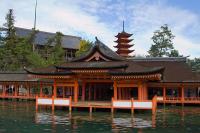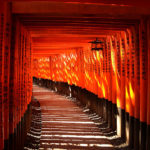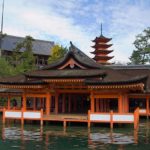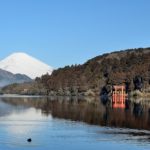Table of Contents
Miyajima Island where there is Itsukushima Shrine (World Heritage Site)

The red torii gate stands calmly and solidly in the Inland Sea Seto. It is really impressive scene. The torii at Miyajima Island is famous as well as the Thousands Torii Gate of Fushimi Inari Taisha Shrine in Kyoto City.
Itsukushima Shrine was registered as a cultural site of World Heritage Site in 2006. Actually, the history of the Itsukushima Shrine dates back to 1400 years ago. And there are the events that we can see the traditional Japanese dances at the shrine.
The island is rich in nature and has the temples and shrines. Miyajima is one of the three great views in Japan.
It only takes about one hour from Hiroshima Station to the island. Miyajima is a must-see sight of San-you region.
About Miyajima Island
The holy island has two names. Miyajima (宮島) and Itsukushima (厳島). The former is the name for tourism and usage. And the later is official and used also on the map.
The area of the island is 30.39 km². Though the parts of the south side doesn’ t have a road, a loop around is about 30km. As the Mt. Misen and other mountains have had a solemn and mysterious atmosphere, people have worshiped the nature from the earliest times. The famous red torii and Itsukushima Shrine is located on the northwest side.
Ferry
The island of the population is 1,700 (in 2016) but 4 million tourists visit in a year. When you visit Miyajima, you’ll board the ferry, JR West Miyajima Ferry or Miyajima Matsudai Ferry from Miyajima-guchi of the main land. You can check the fares and timetable on each site.
JR West Miyajima Ferry
West Japan Railway Miyajima Ferry – The closest view of Otorii from the water.
Miyajima Matsudai Ferry
Miyajima Matsudai Kisen Tourist Ship Co., Ltd.
Shrines and temples
Itsukushima Shrine is the most attraction of Miyajima Island, but there are more historic shrines and temples.
Itsukushima Shrine (厳島神社)
It is said that the face of the island was established by the head of a powerful family Saeki-no Kuramoto in 593. More than 600 years later, Taira-no Kiyomori (1118-1181), the head of Taira family, worshiped the shrine and donated a huge endowment. Thanks to that, the whole of the buildings became to consist 37 inner shrines and 19 outer shrines.
Though the numerous natural disasters and fires have attack Itsukushima Shrine, the people with deep faith have repaired and rebuilt. The two-storied pagoda is the important cultural property of the country.
Toyokuni Shrine (豊国神社)
Toyotomi Hideyoshi (1537-1598) ordered to build the shrine in 1587. The architecture is the largest in the island. Since the floor is so spacious, people call it “Thousand tatami-mats palace”.
Kiyomori Shrine (清盛神社)
The shrine was built in 1954 to commemorate the 770th anniversary of Taira-no Kiyomori’s death. In Miyajima Island, the Kiyomori Festival is held in every March.
Omoto Shrine (大元神社)
According to legend, the establishment of Omoto Shrine was earlier than Itsukushima Shrine. The shingle roofs of the shrine are the only existing one today. Saeki-no Kuramoto is one of the deities of the shrine.
Five-storied Pagoda (五重塔)

The important cultural property of the country. The establishment of the architecture was in 1407. It stands next to Toyokuni Shrine. The architectual style is a combination of Japanese and Chinese.
Daiganji Temple (大願寺)
Until an ordinance to distinguish Shinto and Buddhism in 1868, the temple undertook the repairing of the many famous shrines in Japan. Toyokuni Shrine, the two-storied pagoda, and the five-storied pagoda was the part of Daiganji Temple.
Daishoin Temple (大聖寺)
It is the main temple of Omuro school of the Shingon sect. Kukai established the temple in 806. The temple had played part of a steward for Itsukushima Shrine until 1868. It had close links with the successive Imperial Family and they stayed temporarly when they visited Itsukushima Shrine.
Mt. Misen (弥山)

Mt. Misen is also the part of Miyajima World Heritage Site (as natural heritage). The unique mountain has the primitive, coniferous, and southern trees. The whole mountain is Natural Monument of Japan. The hight is 535 m.
But Mt. Misen is meaningful not only about nature but also the religions. Previous to an introduction of the Buddhism to Japan, the people had worshiped the nature including mountains, seas, and rivers just like Mt. Misen.
And the mountain became the important point of Japanese Buddhism when Kukai came and designated it as a base in 806. There are many Buddhism and Shinto architectures on the mountain.
Though you can walk to the top of the mountain, but the ropeway take you there with seeing the beautiful scenery of Miyajima Island and the Inland Sea Seto.
Miraculous scenery | Miyajima Ropeway







